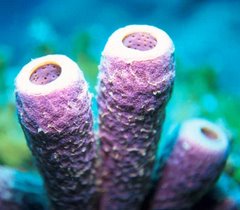
WHAT IS A SEA SPONGE?
Although sea sponges may look like plants, they are the simplest of multi-cellular animals. Sea sponges are bottom-dwelling invertebrate creatures that are primarily marine, however there are a small number of sponge species that can live and survive in freshwater regions. The scientific term for sponges is Porifera, which literally means "pore-bearing". The surface of a sea sponge is made up of thousands of tiny pores, called ostia. These pores lead internally to a system of canals, whose main functions are collecting nutrients and oxygen, and disposing waste and carbon dioxide.
CHARACTERISTICS THAT DEFINE A SEA SPONGE
1. No definite symmetry
2. Body is multicellular but there are no tissues and no organs
3. Most to all adults are sessile
4. Can reproduce both sexually and asexually
5. No nervous system
6. Lives in aquatic environments, mostly marine
7. All are filter feeders
8. Often have a skeleton composed of spicules
9. Cells surround a water filled space though there is no true body cavity
CLASSIFICATION
Sea sponges are classified under the Kingdom Animalia and the Phylum Porifera. Sponges are classified into three taxonomic classes based on the chemical composition of their skeletons:
Calcarea: calcerous sponges; skelteon composed of calcium carbonate; considered the most primative group of sea sponges; include asonoid, syconoid and leuconoid body forms (see ANATOMY)
Demospongiae: horn sponges (ie. bath sponges); skeleton composed of protein fibers; include only leuconoid body forms
Hexactinellida: glass sponges; skeleton composed of silicon dioxide; include only leuconoid body forms
Besides the three afforementioned classes, there is one other class of sea sponges that has not yet been mentioned, sclerospongiae. This class is not considered a taxonomic class of sponges though it still exists. Sclerospongiae includes all coralline or tropical reef sponges.
Although sea sponges may look like plants, they are the simplest of multi-cellular animals. Sea sponges are bottom-dwelling invertebrate creatures that are primarily marine, however there are a small number of sponge species that can live and survive in freshwater regions. The scientific term for sponges is Porifera, which literally means "pore-bearing". The surface of a sea sponge is made up of thousands of tiny pores, called ostia. These pores lead internally to a system of canals, whose main functions are collecting nutrients and oxygen, and disposing waste and carbon dioxide.
CHARACTERISTICS THAT DEFINE A SEA SPONGE
1. No definite symmetry
2. Body is multicellular but there are no tissues and no organs
3. Most to all adults are sessile
4. Can reproduce both sexually and asexually
5. No nervous system
6. Lives in aquatic environments, mostly marine
7. All are filter feeders
8. Often have a skeleton composed of spicules
9. Cells surround a water filled space though there is no true body cavity
CLASSIFICATION
Sea sponges are classified under the Kingdom Animalia and the Phylum Porifera. Sponges are classified into three taxonomic classes based on the chemical composition of their skeletons:
Calcarea: calcerous sponges; skelteon composed of calcium carbonate; considered the most primative group of sea sponges; include asonoid, syconoid and leuconoid body forms (see ANATOMY)
Demospongiae: horn sponges (ie. bath sponges); skeleton composed of protein fibers; include only leuconoid body forms
Hexactinellida: glass sponges; skeleton composed of silicon dioxide; include only leuconoid body forms
Besides the three afforementioned classes, there is one other class of sea sponges that has not yet been mentioned, sclerospongiae. This class is not considered a taxonomic class of sponges though it still exists. Sclerospongiae includes all coralline or tropical reef sponges.


1 comment:
i lovd this blog...it ws helpful....
Post a Comment